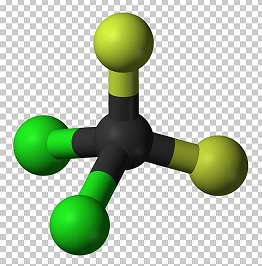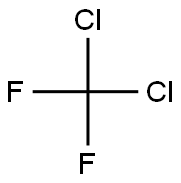디클로로디플루오로메탄
|
|
디클로로디플루오로메탄 속성
- 녹는점
- -158°C
- 끓는 점
- -29.79°C
- 밀도
- 1.329
- 증기압
- 4,306 at 20 °C (McConnell et al., 1975)
- 굴절률
- 1.2850
- 인화점
- 11 °C
- 저장 조건
- -20°C
- 용해도
- 에 용해됨아세트산, 아세톤,클로로포름, 에테르(Weast, 1986) 및 에탄올(ITII, 1986)에 용해됩니다.
- 물리적 상태
- 완충된 글리세롤 수용액
- 색상
- 미묘한 냄새가 나는 무색 가스
- 수용성
- 불용성. 0.028g/100mL
- Henry's Law Constant
- 1.72, 2.63, and 3.91 at 10, 20, and 30 °C, respectively (Munz and Roberts, 1987)
- 노출 한도
- NIOSH REL: TWA 1,000 ppm (4,950 mg/m3), IDLH 15,000 ppm; OSHA PEL: TWA 1,000 ppm; ACGIH TLV: TWA 1,000 ppm (adopted).
- Dielectric constant
- 2.4(21℃)
- 안정성
- 안정적인. 불연성. 알루미늄과 격렬하게 반응할 수 있음.
- InChIKey
- PXBRQCKWGAHEHS-UHFFFAOYSA-N
- LogP
- 2.160
- CAS 데이터베이스
- 75-71-8(CAS DataBase Reference)
- EPA
- CFC-12 (75-71-8)
안전
- 위험 및 안전 성명
- 위험 및 사전주의 사항 (GHS)
| 위험품 표기 | Xn;N,Xi,N,Xn,T,F | ||
|---|---|---|---|
| 위험 카페고리 넘버 | 20-59-23/25-11-39/23/24/25-23/24/25-22 | ||
| 안전지침서 | 23-24/25-59-61-45-24-16-7-36/37 | ||
| 유엔번호(UN No.) | 1028 | ||
| WGK 독일 | 1 | ||
| 위험 참고 사항 | Irritant | ||
| DOT ClassificationII | 2.2 (Nonflammable gas) | ||
| 위험 등급 | 2.2 | ||
| 유해 물질 데이터 | 75-71-8(Hazardous Substances Data) | ||
| 독성 | LD50 for rats >1 g/kg (quoted, Verschueren, 1983). | ||
| IDLA | 15,000 ppm | ||
| 기존화학 물질 | KE-10106 |
디클로로디플루오로메탄 C화학적 특성, 용도, 생산
개요
Dichlorodifluoromethane is known as CFC-12, also called R-12, or Freon-12. R-12 is a general name for Refrigerant-12. Freon is a trade name for DuPont. CFC stands for chlorofl uorocarbons, which are nontoxic, nonfl ammable, synthetic chemicals containing atoms of carbon, chlorine, and fluorine.CFC use climbed steadily worldwide as it was incorporated in refrigeration and air conditioning, as well as being used as propellants, blowing agents, and solvents.
dichlorodifluoromethane structure
화학적 성질
Dichlorodifluoromethane is a liquefied gas and exists as a liquid at room temperature when contained under its own vapor pressure, or as a gas when exposed to room temperature and atmospheric pressure. The liquid is practically odorless and colorless. The gas in high concentrations has a faint etherlike odor. Dichlorodifluoromethane is noncorrosive, nonirritating, and nonflammable. Ethereal odor at .20% by volume. Shipped as a compressed gas.Dichlorotetrafluoroethane is a colorless, nonflammable liquefied gas with a faint, ethereal odor.
Trichloromonofluoromethane is a clear, volatile liquid at room temperature and atmospheric pressure. It has a characteristic carbon tetrachloride-like odor and is nonirritating and nonflammable.
역사
CFCs were developed in the 1930s as coolants for refrigerator, freezer, and motor vehicle air conditioners.they subsequently found use as metal cleaners, degreasers, propellants, solvents, and blowing agents in the production of foams. CFCs have received widespread environmental attention because of their potential to deplete stratospheric ozone.용도
Refrigerant, aerosol propellant.Dichlorodifluoromethane is used as a refrigerant gas in refrigerators and air conditioners.
Dichlorodifluoromethane is also used in aerosol sprays, in plastics, and as an aid in detecting leaks.
Dichlorodifluoromethane harms the ozone layer, which protects the earth from the sun’s ultraviolet radiation.
생산 방법
Dichlorodifluoromethane is prepared by the reaction of hydrogen fluoride with carbon tetrachloride in the presence of a suitable catalyst, such as polyvalent antimony. The dichlorodifluoromethane formed is further purified to remove all traces of water and hydrochloric acid as well as traces of the starting and intermediate materials.Trichloromonofluoromethane is also obtained by this process.
Dichlorotetrafluoroethane is prepared by the reaction of hydrogen fluoride with chlorine and perchloroethylene in the presence of a suitable catalyst such as polyvalent antimony.
일반 설명
A colorless gas having a faint ethereal odor. Shipped as a liquid confined under its own vapor pressure. Contact with the unconfined liquid can cause frostbite. Both components are noncombustible. Can asphyxiate by the displacement of air. Exposure of the closed container to prolonged heat or fire can cause Dichlorodifluoromethane to rupture violently and rocket.공기와 물의 반응
The liquefied gas poured into water can be violently explosive. This is due to the phase transition from superheated liquid to vapor.반응 프로필
The reaction of aluminum with various halogenated hydrocarbons produces a self-sustaining reaction with sufficient heat to melt aluminum pieces, examples of other halogenated hydrocarbons are fluorotrichloromethane, Dichlorodifluoromethane, chlorodifluoromethane, tetrafluoromethane. The vigor of the reaction appears to be dependent on the combined degree of fluorination and the vapor pressure, [Chem. Eng. News 39(27):44(1961)].건강위험
INHALATION: some narcosis when 10% in air is breathed.Safety Profile
Dichlorodifluoromethane is a colorless, non-flammable gas that can affect you when breathed in. Acute (short-term) exposure to dichlorodifluoromethane can cause dizziness, lightheadedness, and trouble with concentration. Exposure to high concentrations of the gas can cause the heart to beat irregularly or to stop. The health effects of chronic (long-term) exposure to dichlorodifluoromethane are unknown at this time. There is no evidence of an increase in cancer risk due to exposure to dichlorodifluoromethane.잠재적 노출
Dichlorodifluoromethane is used as an aerosol propellant, refrigerant and foaming agentCarcinogenicity
There was no evidence of carcinogenicity when groups of 50 male and 50 female rats were given oral doses of 15 or 150 mg/kg of CFC 12 daily for 2 years. As described above, there was no evidence of carcinogenicity when groups of 90 male and 90 female rats and of 60 male and 60 female mice were exposed by inhalation to levels of 1000 and 5000 ppm, 4 h/day, 5 days/ week.환경귀착
Surface Water. Estimated half-lives of dichlorodifluoromethane from an experimental marine mesocosm during the spring (8–16 °C) and winter (3–7 °C) were 20 and 13 d, respectively (Wakeham et al., 1983).저장
Chlorofluorocarbon propellants are nonreactive and stable at temperatures up to 5508℃. The liquefied gas is stable when used as a propellant and should be stored in a metal cylinder in a cool, dry place.운송 방법
UN1028 Dichlorodifluoromethane or Refrigerant gas R-12, Hazard class: 2.2; Labels: 2.2-Nonflammable compressed gas. Cylinders must be transported in a secure upright position, in a well-ventilated truck. Protect cylinder and labels from physical damage. The owner of the compressed gas cylinder is the only entity allowed by federal law (49CFR) to transport and refill them. It is a violation of transportation regulations to refill compressed gas cylinders without the express written permission of the ownerPurification Methods
Pass the gas through saturated aqueous KOH then conc H2SO4, and a tower packed with activated copper on Kielselguhr at 200o removed CO2 and O2. A trap cooled to -29o removed a trace of high boiling material. It is a non-flammable propellant.비 호환성
The presence of greater than 5% water in solutions that contain trichloromonofluoromethane may lead to hydrolysis of the propellant and the formation of traces of hydrochloric acid, which may be irritant to the skin or cause corrosion of metallic canisters. Trichloromonofluoromethane may also react with aluminum, in the presence of ethanol, to cause corrosion within a cylinder with the formation of hydrogen gas. Similarly, alcohols in the presence of trace amounts of oxygen, peroxides, or other free-radical catalysts may react with trichloromonofluoromethane to form trace quantities of hydrochloric acid.Both dichlorodifluoromethane and dichlorotetrafluoroethane are compatible with most ingredients used in pharmaceutical aerosols. Because of their poor miscibility with water, most MDIs are formulated as suspensions. However, solution MDIs can be prepared through the use of ethanol as a cosolvent for water and propellant, resulting in a clear solution (provided the water content is less than 5%).
폐기물 처리
Return refillable compressed gas cylinders to supplier. Incineration, preferably after mixing with another combustible fuel. Care must be exercised to assure complete combustion to prevent the formation of phosgene. An acid scrubber is necessary to remove the halo acids produced. Because of potential ozone decomposition in the stratosphere, R-12 should be released to the atmosphere only as a last resort. Consult with environmental regulatory agencies for guidance on acceptable disposal practices. Generators of waste containing this contaminant (≥100 kg/mo) must conform with EPA regulations governing storage, transportation, treatment, and waste disposalRegulatory Status
Included in the FDA Inactive Ingredients Database (aerosol formulations for inhalation, nasal, oral, and topical applications). With few exceptions for existing MDIs, the FDA and EPA have banned the use of CFCs in the USA after 31st December 2008, with all CFCs to be phased out by 2010–2015. Included in nonparenteral medicines licensed in the UK.디클로로디플루오로메탄 준비 용품 및 원자재
원자재
준비 용품
디클로로디플루오로메탄 관련 검색:
디클로로메탄 1,1,2-트리클로로-1,2,2-트리플루오로에탄 클로로디플루오르메탄 플루오로폼(플루오르포름) 브로모클로로디플루오로메탄 다이클로로모노플루오로메테인(디클로로모노플루오로메탄) 디클로로디플루오로메탄 트라이플루오로모노브로모메테인 1,1-다이클로로-1-플루오로에테인 불화 메틸렌
Zinc trifluoromethanesulfonate
Trifluoromethyl iodide
Diphenyldichloromethane
DICHLORODIFLUOROMETHANE (CFC-12)
Chlorofluoromethane
Dichlorodifluoromethane and difluoroethane azeotropic mixture
Ethylene oxide and dichlorodifluoromethane mixtures,with not more than 12% ethylene oxide,Dichlorodifluoromethane and epoxyethane mixtures
Refrigerant









